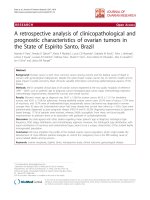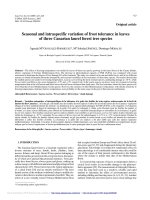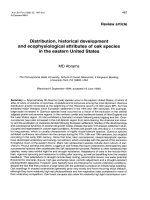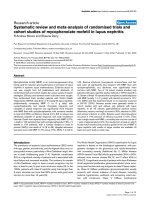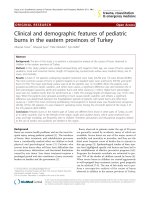MOLECULAR AND PHYSIOLOGICAL STUDIES OF SALT TOLERANCE IN THE SALT SECRETOR MANGROVE AVICENNIA OFFICINALIS
Bạn đang xem bản rút gọn của tài liệu. Xem và tải ngay bản đầy đủ của tài liệu tại đây (5.96 MB, 218 trang )
MOLECULAR AND PHYSIOLOGICAL STUDIES OF
SALT TOLERANCE IN THE SALT-SECRETOR
MANGROVE
AVICENNIA OFFICINALIS
Pavithra Amruthur Jyothi-Prakash
(M. Sc. Biochemistry, University of Mysore, India)
A THESIS SUBMITTED FOR THE DEGREE OF
DOCTOR OF PHILOSOPHY (Ph. D.)
DEPARTMENT OF BIOLOGICAL SCIENCES
FACULTY OF SCIENCE
NATIONAL UNIVERSITY OF SINGAPORE
2015
ii
Declaration
I hereby declare that this thesis is my original work and it has been written
by me in its entirety. I have duly acknowledged all the sources of
information which have been used in the thesis.
This thesis has also not been submitted for any degree in any university
previously.
Pavithra Amruthur Jyothi-Prakash
January 2015
iii
Acknowledgements
The journey started with a simple curiosity towards natural processes and all it
took for this thesis to happen was a lot of courage, hard work, enthusiasm,
endurance, persistence and sacrifices. But it could not have been completed
without support from others. I would like to extend my gratitude for everyone who
contributed to my success.
I would like to express my sincere gratitude to my supervisors, Prof. Prakash
Kumar and A/P Loh Chiang Shiong for their continuous support, patience and
guidance, which has shaped me to become a better person and a budding
scientist.
I would like to thank both my Plant Biology and Plant Morphogenesis lab
members for timely guidance and support whenever required. I would like to
thank Dr. Tan Wee Kee for helping me initiate the project. Special thanks to Dr.
Pannaga, for her involvement in discussions, suggestions and comments on the
experimental design and setup. This has significantly contributed to the quality of
my work. My thesis would not have been complete without her valuable inputs. I
would like to thank Dr. Ram, Dr. Petra, Dr. Vijay and Dr. Vivek for sharing their
expertise and for the technical advice related to my work. It was a pleasure
working closely with Dr. Pratibha for a few experiments which gave me a good
experience in troubleshooting. I would like to extend my thanks to Bhushan, Amrit
and Anindita for a fun-filled environment in the lab and immense support during
tough times. My sincere gratitude to Mrs. Ang, our lab officer who has been
supportive in catering the laboratory needs without delay. I would like to thank Dr.
iv
Bijayalakshmi Mohanty for her constant support and immense help with
bioinformatic analyses in my work.
I would like to thank Prof. Mathew M. K. from NCBS, Bangalore, India who
supported a part of aquaporin work by providing his resources. I am thankful for
all his lab members who helped me during my work. My special thanks to Savita
Bhagat and Shishupal Singh who were instrumental in completing my work at
NCBS.
I would like to extend my thanks to Department of Biological Sciences, NUS
Environmental Research Enterprise and SPORE, NUS for the providing me the
Research Scholarship. Consumables and traveling grant for overseas research
work was supported by the Singapore National Research Foundation under its
Environmental & Water Technologies Strategic Research Programme and
administered by the Environment & Water Industry Programme Office (EWI) of
the PUB, Singapore, NRF-EWI-IRIS (2P 10004/81) (R-706-000-010-272). My
sincere thanks go to NParks Board, Singapore for extending permission to collect
mangrove samples in Singapore.
Many thanks to my friends Pradeep, Bidhan, Pramila, Narayani, Madhuri, Manali,
Varuna and Pavithra Singaravelu who were a wonderful company during my Ph.
D. My special thanks to Shruti, Ananya and Kameshwari for the quality time we
had together at UTown residence, which added incredible memories to my Ph. D.
journey.
I acknowledge the support of my entire family for believing in my potential and
special thanks to my parents, my brother and my husband for their continuous
support and understanding, without them this journey would not have been
v
possible. Finally, thanks to all my teachers, for their support, teachings and
blessings.
Lastly, I am grateful to all the helping hands, which were extended to me at the
right time, which would be a long list to mention here. Thank you one and all.
vi
Publications
(Parts of the contents of the thesis are described in these articles)
1. Jyothi-Prakash PA, Mohanty B, Wijaya E, Lim TM, Lin Q, Loh C-S
and Kumar PP (2014) Identification of salt gland-associated genes and
characterization of a dehydrin from the salt secretor mangrove Avicennia
officinalis. BMC Plant Biology 14-291
2. Krishnamurthy P, Jyothi-Prakash PA, Qin Lin, He Jie, Lin Q, Loh
C-S, Kumar PP (2014) Role of root hydrophobic barriers in salt exclusion
of a mangrove plant Avicennia officinalis. Plant, Cell & Environment,
37(7):1656-1671
Other Publications:
(Content from this article is not related to the thesis)
El-Sharkawy, S. Sherif, W. El Kayal, A. Mahboob, K. Abubaker, P.
Ravindran, P. A. Jyothi-Prakash, P. P. Kumar and S. Jayasankar (2013).
Characterization of gibberellin-signalling elements during plum fruit
ontogeny defines the essentiality of gibberellin in fruit development. Plant
Molecular Biology: 1-15
Conference Contributions:
1. 18
th
Biological Sciences Graduate Congress, December 2014,
Malaysia
Oral presentation: Molecular and physiological studies of salt secretion in
mangrove plant. Pavithra A. J, Loh C-S, Kumar PP
2. 17
th
Biological Sciences Graduate Congress, December 2012,
Thailand
Oral presentation: Molecular and physiological studies of salt secretion in
mangrove plant. Pavithra A. J, Loh C-S, Kumar PP
vii
Contents
Declaration ii
Acknowledgements iii
Publications vi
Summary ix
List of Tables xii
List of Figures xii
List of abbreviations xiv
Chapter 1: Introduction 2
1.1 Salt and soil salinity 2
1.2 Status of mangrove forest in Singapore 5
1.3 Salt balance in mangrove plants 6
1.4 Effect of salinity on growth and development of plants 8
1.5 Mechanisms to minimize damage from high salinity 10
1.6 Objectives of the study and approach 17
Chapter 2 : Materials and methods 21
2.1 Plant materials and growth conditions 21
2.2 Plasmid construction 30
2.3 Plant transformation 35
2.4 Seed sterilization and germination assay in Arabidopsis 39
2.5 Southern blotting 40
2.6 Isolation and transfection of Arabidopsis mesophyll protoplasts 41
2.7 Physiological methods 42
2.8 Quantification of hormones 46
2.9 Non-radioactive RNA In Situ Hybridization 48
2.10 Functional assay of AoDHN1 in E. coli 54
2.11 Swelling assay in Xenopus laevis oocyte system 55
2.12 Tissue preparation for subtractive hybridization 56
2.13 Tissue preparation for transcriptome analysis 57
Chapter 3 : Physiological and morphological studies in Avicennia officinalis 60
3.1 Background 60
3.1 Results 63
3.3 Discussion 78
viii
Chapter 4 : Subtractive Hybridization study 86
4.1 Background 86
4.2 Results 89
4.3 Discussion 107
Chapter 5 : Transcriptome study 116
5.1 Background 116
5.2 Results 119
6.3 Discussion 129
Chapter 6 : Aquaporin study 135
6.1 Background 135
6.2 Results 143
5.3 Discussion 172
Chapter 7 : Limitations and recommendations 181
Chapter 8 : General conclusions 185
References: 189
ix
Summary
Salt secretion is a specialized salt tolerance mechanism observed in
mangrove plants. Several studies on mangroves had focussed on the
structure of salt glands and salt secretion pattern, while, very few studies
described the functional aspects of salt secretion. The present study
focussed on preliminary analysis of salt filtration at the roots, salt secretion
at the leaves and the effect of salt concentration on secretion using
Avicennia officinalis seedlings that were not exposed to salt previously.
Furthermore, to understand the molecular mechanisms underlying the
secretion at the salt glands, differential gene expression in response to
salt treatment was examined in the salt gland-rich tissues using
subtractive hybridization and transcriptomics.
The present study showed that the amount of salt in the external medium
plays an important role in triggering salt secretion. Higher concentration of
salt in the external medium leads to increases in xylem salt content and
secretion rate. Increased levels of the stress hormones, namely, abscisic
acid (ABA) and jasmonic acid (JA) were observed in salt-treated seedling
tissues, but the other hormones such as gibberellins (GAs) and salicylic
acid (SA) did not show significant variation in relation to salt treatment.
Using subtractive hybridization method, an attempt was made to identify
key genes that are differentially regulated in salt gland-rich adaxial
epidermal tissues of leaves. Among the 34 genes that were enriched in
the salt gland-rich tissue, a Dehydrin gene (AoDHN1) showed nearly 6-
fold increase in expression. Dehydrins are known to be involved in stress-
x
remediation in other plants, and hence, AoDHN1 was chosen for further
analysis. AoDHN1 expression was high in A. officinalis leaves and
specifically in salt glands as indicated by quantitative RT-PCR and in situ
hybridization. To check its stress-remediation effect, AoDHN1 was
expressed in E. coli cells that were subjected to salinity and drought stress
conditions. The growth of E. coli cells expressing AoDHN1 was
significantly higher compared to control cells without AoDHN1, suggesting
a significant role for AoDHN1 in mediating salt stress.
Aquaporins are known to play an important role during drought and salt
stress conditions and are also known to be involved in salt secretion in
mangroves. Therefore, three aquaporin genes from A. officinalis, namely,
AoPIP1.1, AoPIP1.2 and AoPIP2.2 were cloned and sequenced. These
aquaporins showed significant increase in transcript levels within 90min of
drought stress, but not in response to ABA and salinity treatments. From a
functional assay in Xenopus laevis oocytes, AoPIP1.1 and AoPIP1.2 were
found to exhibit water transport activity. Also, expression of AoPIP1.2 was
high in salt gland-rich tissues compared to the transcript levels of
AoPIP1.1 and AoPIP2.2. Furthermore, in situ hybridization study of
AoPIP1.2 showed abundant expression in salt gland cells, suggesting that
AoPIP1.2 could be involved in the water transport activity associated with
salt secretion.
Subtractive hybridization study yielded only a limited number of
differentially expressed genes. Therefore, to study the global gene
expression changes upon salt treatment, a transcriptome analysis was
performed using salt gland-enriched tissues. The focus was on early
xi
response genes whose expression levels were altered after 30min of salt
treatment. RNA sequencing showed 646 up-regulated and 1132 down-
regulated genes. Due to the lack of genome sequence information, only a
relatively small number of differentially regulated genes could be
annotated. Future characterization of the ‘unknown genes’ may provide
valuable insights on the salt gland function. Functional grouping of the
annotated genes showed that several of them belonged to transcription,
metabolism, membrane trafficking, transport and stress-related classes.
Gene network analysis of the differentially regulated transcripts showed a
tight interaction among the transport-related genes in the salt-treated
tissues. This suggests that more detailed work with genes selected from
the transcriptome analysis, especially those located at critical interaction
nodes can provide insights on mechanisms of salt secretion.
On the whole, this study has focussed on both physiological and molecular
aspects of salt tolerance in A. officinalis. The notable contributions of this
study include confirmation of the role of AoDHN1 in stress remediation
and identification of a water transporting aquaporin AoPIP1.2.
Furthermore, the observation that their expression is highly enriched in
salt gland cells, suggests that both these genes may play a significant role
in salt secretion and therefore the salt tolerance mechanism in the
mangrove Avicennia officinalis. These results validate the previous
findings that aquaporins play a critical role in salt secretion and water
reabsorption in this species. While we recognise the need for additional
work, these findings help to identify avenues for further research aimed at
elucidating the underlying mechanisms of salt secretion and tolerance.
xii
List of Tables
Table 4.1: Avicennia officinalis ESTs identified from salt gland-rich tissue after
subtractive hybridization. 89
Table 6.1: List of Avicennia officinalis aquaporins identified from transtriptome study 143
List of Figures
Figure 1.1: Global estimate of saline affected land area 2
Figure 2.1: Mangrove swamp near Berlayer Creek Singapore 21
Figure 3.1: Sections of A. officinalis young and mature leaves 65
Figure 3.2: Adaxial and abaxial surfaces of A. officinalis fresh and dried leaves 66
Figure 3.3: Determination of salt gland density in A. officinalis leaves 67
Figure 3.4: Salt gland structure from A. officinalis leaves 69
Figure 3.5: Estimation of ions in xylem sap of A. officinalis 71
Figure 3.6: Estimation of ions in leaf secretions of A. officinalis 74
Figure 3.7: Percentage of hormones estimated from different tissues of field-grown
Avicennia officinalis trees 76
Figure 3.8: Quantification of hormones in leaves of two-month-old A. officinalis
seedlings up on salt treatment. 77
Figure 3.9: Quantification of hormones in roots of two-month-old A. officinalis seedlings
up on salt treatment. 78
Figure 4.1: Classification of differentially expressed ESTs and expression analysis of
selected ESTs 93
Figure 4.2: Expression analysis of ESTs with less than twofold difference in expression
or with higher expression in the mesophyll tissue. 94
Figure 4.3: Functional gene-network analysis of the ESTs identified from Subtractive
Hybridization. 97
Figure 4.4: cDNA and genomic DNA sequences of AoDHN1. 98
Figure 4.5: Secondary structure of AoDHN1, AoDHN2 and AmDHN1. 100
Figure 4.6: Classification of AoDHN1 into Group II LEA protein based on sequence
alignment and phylogenetic analysis. 101
Figure 4.7: AoDHN1 copy number in the genome. 103
Figure 4.8: Expression profile of AoDHN1. 104
Figure 4.9: Sub-cellular localization of GFP fused AoDHN1 in Arabidopsis mesophyll
protoplasts. 105
Figure 4.10: Comparison of growth of E. coli cells expressing AoDHN1 under salt and
drought stress conditions. 107
Figure 5.1: Schematic representation of NGS work flow 120
Figure 5.2: Overview of results obtained from transcriptomic study 122
Figure 5.3: Experimental verification of differentially expressed genes identified from the
transcriptome study using qRT-PCR analysis. 123
Figure 5.4: Functional gene-network analysis of the genes identified from transcriptomic
study (control). 125
xiii
Figure 5.5: Functional gene-network analysis of the genes identified from transcriptomic
study (differentially up-regulated genes). 127
Figure 5.6: Functional gene-network analysis of the genes identified from transcriptomic
study (differentially down-regulated genes). 128
Figure 6.1: Schematic representation of secondary structure of an aquaporin 136
Figure 6.2: The phylogenetic relationship of A. officinalis aquaporins identified from the
transcriptome study with reference to A) rice and B) Arabidopsis aquaporins. 147
Figure 6.3: Expression pattern of A. officinalis aquaporins identified from transcriptome
study 149
Figure 6.4: cDNA and genomic DNA sequences of AoPIP1.1 151
Figure 6.5: Phylogenetic analysis and sequence alignment of AoPIP1.1 152
Figure 6.6: Sub-cellular localization of GFP fused AoPIP1.1 in Arabidopsis mesophyll
protoplasts 155
Figure 6.7: Expression profile of AoPIP1.1 156
Figure 6.8: cDNA and genomic DNA sequences of AoPIP1.2 158
Figure 6.9: Phylogenetic analysis and sequence alignment of AoPIP1.2 159
Figure 6.10: Sub-cellular localization of GFP fused AoPIP1.2 in Arabidopsis mesophyll
protoplasts 161
Figure 6.11: Expression profile of AoPIP1.2 163
Figure 6.12: cDNA and genomic DNA sequences of AoPIP2.2 165
Figure 6.13: Phylogenetic analysis and sequence alignment of AoPIP2.2 166
Figure 6.14: Sub-cellular localization of GFP fused AoPIP2.2 in Arabidopsis mesophyll
protoplasts 167
Figure 6.15: Expression profile of AoPIP2.2 169
Figure 6.16: Osmotic permeability of aquaporins AoPIP1.1, AoPIP1.2 and AoPIP2.2
studied in Xenopus laevis oocytes. 171
Figure 6.17: Germination assay upon salt stress in Arabidopsis transgenic plants
expressing A. officinalis aquaporins genes. 172
xiv
List of abbreviations
Others
ABRC
BLAST
Arabidopsis
Biological Resource
Center
Basic Local
Alignment Search
Tool
cDNA
complementary
deoxyribonucleic
acid
DNA
deoxyribonucleic
acid
DNase
deoxyribonuclease
dNTP
deoxynucleotide
triphosphate
et al.
et alii (Latin for 'and
others')
EST
Expressed
Sequence Tag
FW
Forward primer
LB
Luria Bertani
LC
Liquid
chromatography
MS
Murashige & Skoog
mRNA
messenger RNA
PCR
Polymerase Chain
Reaction
qRT-PCR
quantitative Real
Time -Polymerase
Chain Reaction
RACE
Random
Amplification of
cDNA Ends
RNase
Ribonuclease
RNA
ribonucleic acid
RV
Reverse primer
RT
Room Temperature
SH
SE
Subtractive
Hybridization
Standard error
Taq
Thermophilus
aquaticus
T-DNA
Transfer-Deoxyribo
Nucleic Acid
WT
Wild type
Units and measurements
%
percent
°C
Ω
degree Celsius
ohm
μg
microgram
μl
microliter
μM
micromolar
bp
base pairs
cm
centimeter
g
acceleration of gravity
g/l
gram per litre
g/ml
gram per millilitre
h
hour
kb
kilo base pairs
kDa
kilo Dalton
l
liter
M
molar (moles per liter)
mg
milligram
min
minute
ml
millilitre
mm
millimetre
mM
millimolar
ng
nanogram
nm
nanometer
nl
nanoliter
OD
600
optical density at
600nm
pH
power of hydrogen
ppm
parts per million
RH
relative humidity
rpm
revolutions per minute
s
second
V
Volt
v/v
volume by volume
percent
w/v
weight by volume
percent
xv
Chemicals
ABA
abscisic acid
Amp
ampicillin
CaCl
2
calcium chloride
DEPC
diethylpyrocarbonate
DIG
digoxigenin
EDTA
ethylene diamine
tetraacetic acid
GA
gibberellic acid
HCl
hydrochloric acid
IAA
indole acetic acid
JA
jasmonic acid
Kan
kanamycin
MgCl
2
magnesium chloride
NaCl
sodium chloride
Na
2
HPO
4
disodium phosphate
NaH
2
PO
4
monosodium
phosphate
PBS
phosphate-buffered
saline
PEG
polyethylene glycol
PVA
polyvinyl alcohol
PVDF
polyvinylidene
difluoride
SDS
sodium dodecyl
sulfate
SSC
saline-sodium citrate
SA
salicylic acid
TAE
Tris/acetic acid/EDTA
Tris
Tris (hydroxymethyl)
aminomethane
Tween20
polyoxyethylene
sorbitan monolaurate
dH
2
O
deionized water
Gene / protein names and
descriptions
DHN
Dehydrin
PIP
Plasma membrane
Intrinsic Protein
TIP
Tonoplast Intrinsic
Protein
NIP
Nod26-like Intrinsic
Protein
SIP
Small-basic Intrinsic
Protein
SOS
Salt Overly Sensitive
NHX
Sodium Hydrogen
Exchangers
BSA
bovine serum
albumin
YFP
Yellow Fluorescent
Protein
GFP
Green Fluorescent
Protein
CHAPTER 1
1
CHAPTER 1
Introduction
CHAPTER1
2
Chapter 1: Introduction
1.1 Salt and soil salinity
No toxic substance limits the plant growth more than salt on world scale
(Xiong and Zhu, 2002). 800 million hectares of land is affected by salinity,
which corresponds to ~6% of world’s total land area (Munns and Tester,
2008). Soil salinity has been one of the major problems in efficient land
usage for agriculture and affects crop yield worldwide. Of the 1500 million
hectares of land used for dryland agriculture, 32 million hectares (2%) are
affected by secondary salinity to varying degrees. Of 230 million hectares
of irrigated land, 45 million hectares (20%) are salt affected. The total
irrigated land accounts for only 15% of total cultivated land. Due to the
increasing demand for crop yield and the decrease in cultivable land area,
it is important to engineer salt tolerant crop varieties that can be grown in
salt affected areas.
Figure 1.1: Global estimate of saline affected land area
CHAPTER1
3
(
Salt is a natural element in soil and water. USDA salinity lab defines saline
soil as soils having an Electrical Conductivity (EC
e
) of 4dS/m or more
(~3g/l salt) (Ashraf et al., 2008). Natural or primary salinity occurs in arid
and semi-arid areas, which receive inadequate rainfall. Secondary or
human induced salinity occurs, when the balance between soil and water
is perturbed, especially by clearing natural vegetation (plants with deep
roots) and converting these lands to cultivate plants (crops) with shallow
roots. This causes underground water (rich in salts) to rise by capillary
action and moving salts to the soil surface (Munns, 2002).
Soil salinity is caused by elevated levels of various salts in soil. All salts
may not inhibit the growth of plant but can affect the plant in various ways.
In saline soils, Na
+
and Cl
-
have been reported to be the principal toxic
ions, which affect plant growth and productivity. In woody perennials like
grapevines and citrus, roots and woody stems retain Na
+
and Cl
-
protecting the leaves from the damaging effects of Na
+
on photosynthesis
(Flowers and Yeo, 1986). For many plants like graminaceous crops, Na
+
is
the primary cause of ion-specific damage.
Both drought and salinity result in osmotic stress that may lead to
inhibition of growth in plants. But not all plants are susceptible for salt
stress to the same extent. 2% of the world’s plant population constitutes
halophytes, which are resistant to salt stress (Glenn et al., 1999).
Chenopodiaceae has about 550 halophyte species, forms the largest
group of halophytes - Atriplex, Allenrolfea, Arthrocnemum, Halimione,
CHAPTER1
4
Nitrophila, Salicornia and Suaeda are some members of that family
(Aronson, 1989). Studies including germination and growth under salt
stress, functional characterization of salt tolerant genes from Atriplex (Jia
et al., 2002; Ohta et al., 2002; Ungar, 1996), Suaeda (Flowers, 1972;
Hajibagheri et al., 1985; Yeo and Flowers, 1980) and Salicornia
(Moghaieb et al., 2004; Rivers and Weber, 1971) have been carried out.
Furthermore, Thellungiella halophila, a relative of Arabidopsis is a
halophyte, which has been widely studied to understand the salt tolerance
property of the plant. Many comparative studies of Thellungiella with
Arabidopsis relating to the salt tolerance aspects for example, genomic,
proteomic and physiological aspects were carried out (Ghars et al., 2008;
Gong et al., 2005; Pang et al., 2010). These are some halophytes (other
than mangroves) extensively studied to evaluate salt tolerance properties
compare to glycophytes. Even though, these studies provide substantial
amount of information, further investigation is necessary to correlate the
key differences of glycophyte and halophyte mechanisms to survive in
saline environments.
In general, halophytes compete with glycophytes in saline conditions and
grow well due to their adaptive capabilities at both cellular and whole plant
levels. Both halophytes and glycophytes respond to salt in a similar way,
i.e., at physiological level the salt, which enters the roots is transported to
shoot and at cellular level, the salt is either compartmentalized into the
vacuoles (Tester and Davenport, 2003) or deposited in the cell wall
(Flowers et al., 1991). Even during development, Na
+
concentration in
young and growing tissues of halophytes is lower than the mature ones.
CHAPTER1
5
This suggests a need to protect metabolically active cells from deleterious
effect of Na
+
, similar to glycophytes (Flowers and Yeo, 1986). Mature
plants show a better tolerance by evolving mechanisms to thrive in saline
conditions (Thiyagarajah et al., 1996). Several such adaptations could be
found in halophytes that are not found in glycophytes, thus studying such
adaptations becomes necessary to understand the mechanism of salt
tolerance in halophytes.
1.2 Status of mangrove forest in Singapore
Though there are smaller patches of mangrove plants grown in Berlayer
Creek, the largest intact mangrove forest in Singapore mainland is from
Sungei Buloh Wetland Reserve to Kranji Dam. In a study in 1946
mangroves covered an area of 117.3ha and were dynamically advancing
over the coastal swampy regions until 1980. Even after an increased area
of 6.24ha of mangroves was observed, due to clearance for aquaculture,
the total area covered by mangroves was reduced by ~50% by 1980. Later
to 1980, a reduction in sediment supply led to the initiation of erosion
along much of the coastline due to the construction of the Kranji Dam,
immediately east of the study area, with the mangrove fringe having
removed by up to 50m in 2001. These are some important changes that
have been revealed from an analysis of a time series from the period 1946
to 2001 in the distribution of mangroves in Singapore. After establishment
of the wetland reserve in 1992, partial regeneration of mangroves of
~86.8ha has occurred (Bird et al., 2004). A total of 35 true mangrove
species can be found in Singapore. According to IUCN Bruguiera hainesii,
CHAPTER1
6
Bruguiera sexangula, Ceriops decandra Kandelia obovata and many other
mangrove plants were said to be extinct and later they have been
rediscovered in Singapore. (YANG et al., 2011).
Avicennia species are among the most commonly seen species in our
mangroves of which Avicennia alba, Avicennia marina, Avicennia
rumphiana and Avicennia officinalis are found in Singapore (Ng and
Sivasothi, 1999). Avicennia marina is listed as 'Critically Endangered' in
the Red List of threatened plants of Singapore (Davison et al., 2008).
1.3 Salt balance in mangrove plants
Recently, mangroves and mangrove associates have gained more
importance as an alternate source of energy, which could be used to
produce bioethanol and biodiesel (Hui-Min et al., 2012). Mangrove leaves
are known to be rich in fatty acids. So, it is proposed that oils extracted
from mangrove leaves could be used as alternative source of energy.
Mangroves have also acquired attention for medicinal properties and as a
source for fibre.
Mangroves are located at the interface between land and sea. Because
mangroves successfully reside in high saline environments, it is beneficial
to understand the mechanisms by, which they adapt to their environment.
True mangroves are diverse in occurrence, which include 54 species in 20
genera belonging to 16 families (Hogarth, 1999). Depending on the salt
tolerating capacity, halophytes are characterized into obligate or
facultative halophytes. Obligate halophytes show low morphological and
CHAPTER1
7
physiological diversity with relative growth rates increasing up to 50%
seawater. Facultative halophytes are found in less saline habitats and
characterized by broader physiological diversity, which enables them to
cope with saline and non-saline conditions. Vivipary in mangroves is
assumed to be an adaptive characteristic helping to avoid the exposure of
germinating seedling to high salinity. It could be a mechanism to protect
the embryo from the deleterious effects of high salt concentration until
maturity (Hogarth, 1999).
Mangroves regulate salt concentration in the plant tissue through salt
exclusion, salt excretion or salt accumulation, thus classified as either ‘salt
excluders’ or ‘salt secretors’ (Scholander, 1968; Tomlinson, 1986). Salt
excluders (e.g. Rhizophora, Laguncularia Sonneratia) restrict the entry of
ions in the root level itself hence avoid high salt entry into its system. On
the other hand salt secretors, although significant amount of salt entry is
blocked at the roots, generally the filtration efficiency is ~85-90%
(Scholander, 1968) and in some cases up to 95% salt filtration is observed
(Krishnamurthy et al., 2014). While salt is an important component of the
tissue, for movement of water from the roots to the shoots, but the
absorbed amount is still too high and needs to be removed (Kathiresan
and Bingham, 2001). The salt secretors e.g. Avicennia, Acanthus,
Aegiceras take up salt into their system, but secrete out through
specialized salt glands in the leaves (Balsamo and Thomson, 1993;
Drennan et al., 1987; Krishnamurthy et al., 2014; Shimony et al., 1973).
Salt glands are epidermal structures that appear on the leaf surfaces of
several plant genera for example, Plumbaginaceae, Aviceniaceae,
CHAPTER1
8
Tamaricaceae, Frankeniaceae, Chenopodiaceae, Gramineae (Lipschitz
and Waisel, 1974). The major function of salt glands is to secrete mineral
ions like sodium and chloride to regulate internal-ionic composition of the
leaves. They occur as two-celled glands as observed in Gramineae, as
bladder cells seen in Chenopodiaceae or as multi-cellular structure in
Aviceniaceae (Thomson, 1975). Salt glands of Avicennia species consist
of three different types of cells namely secretory, stalk and collecting cells
(Shimony et al., 1973). Ultrastructural studies of these salt glands showed
sunken corn shaped structure of secretory cells, collecting cells at the
bottom and stalk cells are placed between them. These secretory cells of
the salt glands are covered with a layer of cuticle which provides interstitial
space for the movement of water and ions from salt glands to surface of
the leaves. Under salt stress in secretory cells, an increase in endoplasmic
reticulum (ER) network was observed, but on recovery it decreased
significantly (Balsamo and Thomson, 1993). From a previous work on salt
glands during salt stress (Campbell and Thomson, 1976), a general model
was proposed for movement and secretion of salt. Salts, on reaching salt
glands are secreted by exocytosis from secretory cells on the leaf surface.
This process may be mediated by the ER microvesicles providing active
transporters to plasmalemma (Campbell and Thomson, 1976; Kathiresan
and Bingham, 2001).
1.4 Effect of salinity on growth and development of plants
In glycophytes, shoot growth is reduced significantly within a few hours of
salt treatment (Munns, 2002; Munns et al., 2000). This result is primarily
CHAPTER1
9
due to the osmotic effects of the external solution rather than the ionic
effects of Na
+
in the growing tissues. Na
+
damage is particularly
associated with the accumulation of Na
+
in leaf tissues, which leads to
necrosis of older leaves, starting at the leaf-tips, continues to the margins
and later to the petiole of the leaves. Causing ionic stress, Na
+
and Cl
-
also inhibit metabolic processes including protein synthesis. This mainly
reduces the growth and yield of the plants by shortening the lifetime of the
individual leaves, thus affecting net productivity and crop yield (Munns,
1993; Munns and Cramer, 1996). Some effects of high soil Na
+
are also a
result of deficiency of other nutrients (Silberbush and Ben-Asher, 2001) or
of interactions with other environmental factors such as drought, which
magnifies the Na
+
toxicity.
Additionally, metabolic toxicity of Na
+
is also a consequence of its ability to
compete with K
+
for binding sites essential for cellular function.
Approximately 50 enzymes have been identified, which are activated by K
+
and cannot be replaced with Na
+
for their function (Bhandal and Malik,
1988; Kronzucker and Britto, 2011). With high concentration of Na
+
in the
leaf apoplast and the vacuole, plant cells encounter difficulty in
maintaining low cytosolic Na
+
:K
+
ratios. High levels of Na
+
or high Na
+
:K
+
ratios disturb enzymatic processes and ultimately affect cellular function.
Furthermore, protein synthesis requires high concentrations of K
+
, which is
essential for the binding of tRNA to ribosomes (Blaha et al., 2000) and
possibly other aspects of ribosome function (Wyn Jones et al., 1979).
CHAPTER1
10
1.5 Mechanisms to minimize damage from high salinity
Plants employ several strategies to survive under salt stress. Besides
whole plant adaptation to high salinity, an additional feature that involves
every cell within the plant that promotes cellular survival to salinity stress
is essential. Regulation of Na
+
delivery to the shoot comprises of several
steps; entry into root epidermal and cortical cells, a balance between influx
and efflux; loading to the xylem; retrieval from the xylem before reaching
the shoot.
Firstly, the entry of salt should be minimized at the roots. Roots of plants
under salinity stress develop hydrophobic barriers to regulate water and
ionic movement (Krishnamurthy et al., 2011). As it has been shown that
the initial entry of Na
+
from the soil solution into the root cortical cytoplasm
is passive (Cheeseman 1982), developing hydrophobic barriers restrains
movement of toxic molecules. These hydrophobic barriers are basically
suberin polymers deposited in endodermis and exodermis of the roots,
which consequently prevent movement of water and ions (Krishnamurthy
et al., 2011; Steudle, 1994). In mangroves it has been shown that salt
stress induces the formation of hydrophobic barriers, which increases the
salt filtration efficiency in roots by restricting the ion entry through
(Krishnamurthy et al., 2014).
Furthermore, improved efflux of the ions helps to maintain low amounts of
salt in the plants. This can be achieved in several ways. Some plants
accumulate excess salts in senescent leaves or barks of the tress.
